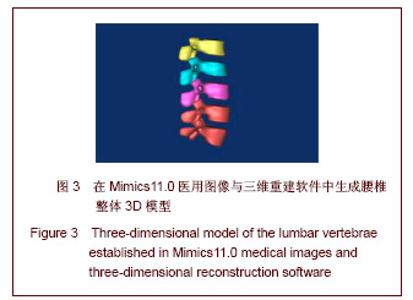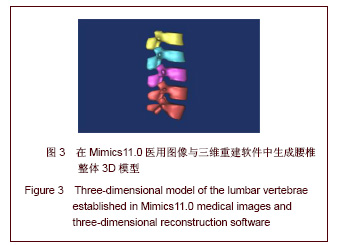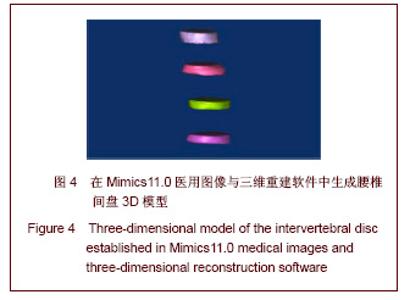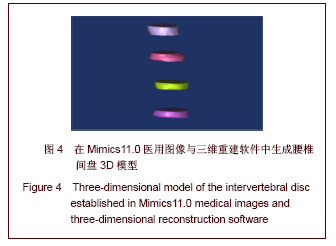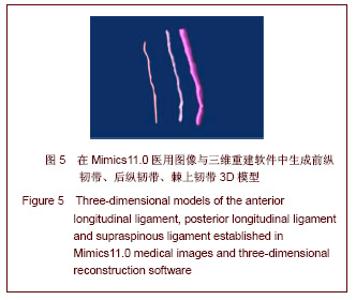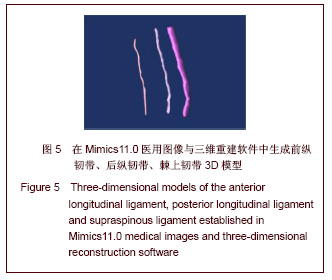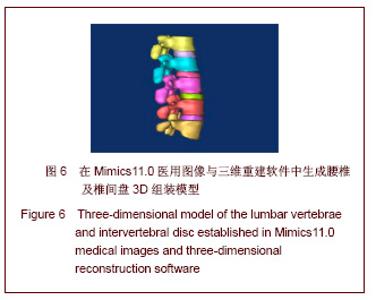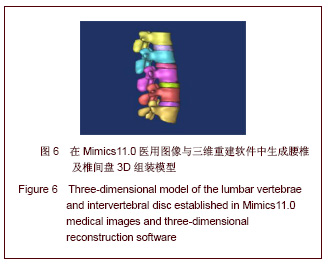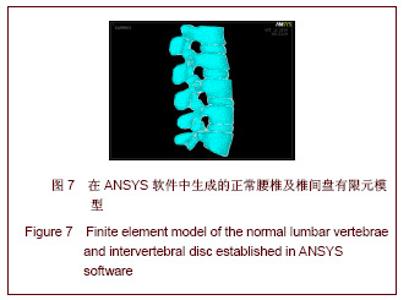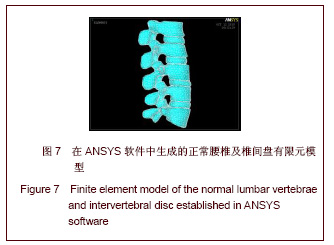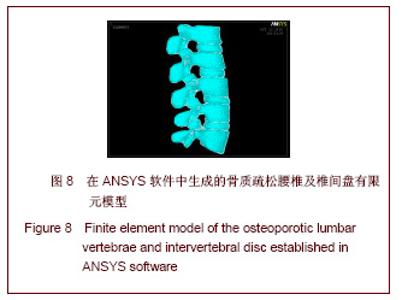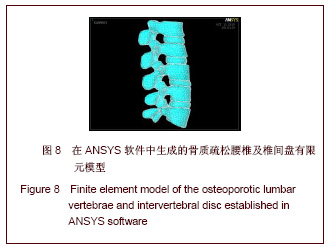| [1] Zhao JN,Shao X,Zeng XF. Renmin Junyi. 1997;40(7):391-392. 赵建宁,邵宣,曾晓峰.脊柱骨折和脊髓损伤系列讲座(1)脊柱骨折和脊髓损伤的病因和分类[J].人民军医,1997,40(7):391-392.[2] Dai LY. Lixue Jinzhan. 1990;20(3):352-366. 戴力扬.人体腰椎生物力学的某些基本问题[J].力学进展,1990, 20(3):352-366.[3] Wang X,Ma X,Tao K,et al.Zhongguo Shengwu Yixue Gongcheng Xuebao.2008;27(2):287-292. 王旭,马昕,陶凯,等.足踝有限元模型的建立与初步临床应用[J].中国生物医学工程学报,2008,27(2):287-292.[4] Pan H.Hefei:Anhui Yike Daxue.2004. 潘宏.踝关节三维有限元模型的建立和临床应用[D].合肥:安徽医科大学,2004.[5] Zhou YN. Shijiazhuang:Hebei Yike Daxue.2010. 周宇宁.足部三维有限元模型的建立和跗跖关节准静态生物力学研究[D].石家庄:河北医科大学,2010.[6] Liu QH, Yu B, Jin D. Shandong Yi yao. 2010;50(14):1-3. 刘清华,余斌,金丹. 解剖结构完整的踝关节有限元模型构建及意义[J].山东医药,2010,50(14):1-3.[7] Wang Z,Zhang JZ.Yiyong Shengwu Lixue Zazhi. 2009;24(2): 148-151. 王智,张建中.足踝部有限元分析的临床应用综述[J].医用生物力学杂志,2009,24(2):148-151.[8] Liu ZH,Yang DZ,Zhu HM,et al. Zhongguo Guzhi Shusong Zazhi. 1999;5(1):1-3. 刘忠厚,杨定焯,朱汉明,等.中国人原发性骨质疏松症诊断标准(试行)[J].中国骨质疏松杂志,1999,5(1):1-3.[9] Liu GQ,Yang QD. Beijing:China Railway Publishing House. 2003. 刘国庆,杨庆东.ANSYS工程应用教程-机械篇[M].北京:中国铁道出版社,2003.[10] Eswaran SK, Gupta A, Adams MF,et al. Cortical and trabecular load sharing in the human vertebral body. J Bone Miner Res. 2006;21(2):307-314.[11] Yoganandan N, Kumaresan S, Pintar FA. Biomechanics of the cervical spine Part 2. Cervical spine soft tissue responses and biomechanical modeling. Clin Biomech (Bristol, Avon). 2001; 16(1):1-27.[12] Yoganandan N, Pintar F, Butler J,et al. Dynamic response of human cervical spine ligaments.Spine (Phila Pa 1976). 1989; 14(10):1102-1110.[13] Lu YM, Hutton WC, Gharpuray VM. Do bending, twisting, and diurnal fluid changes in the disc affect the propensity to prolapse? A viscoelastic finite element model. Spine (Phila Pa 1976). 1996;21(22):2570-2579.[14] Goel VK, Kim YE, Lim TH,et al. An analytical investigation of the mechanics of spinal instrumentation. Spine (Phila Pa 1976). 1988;13(9):1003-1011.[15] Little JP, Adam CJ.The effect of soft tissue properties on spinal flexibility in scoliosis: biomechanical simulation of fulcrum bending.Spine (Phila Pa 1976). 2009;34(2):E76-82.[16] Tsai KH, Lin RM, Chang GL.Rate-related fatigue injury of vertebral disc under axial cyclic loading in a porcine body-disc-body unit.Clin Biomech (Bristol, Avon). 1998;13(1 Suppl 1):S32-S39.[17] Yoganandan N, Kumaresan S, Pintar FA.Geometric and mechanical properties of human cervical spine ligaments.J Biomech Eng. 2000;122(6):623-629.[18] Chosa E, Goto K, Totoribe K,et al. Analysis of the effect of lumbar spine fusion on the superior adjacent intervertebral disk in the presence of disk degeneration, using the three-dimensional finite element method. J Spinal Disord Tech. 2004;17(2):134-139.[19] Chen CS, Feng CK, Cheng CK,et al. Biomechanical analysis of the disc adjacent to posterolateral fusion with laminectomy in lumbar spine. J Spinal Disord Tech. 2005;18(1):58-65.[20] Kumar N, Judith MR, Kumar A,et al. Analysis of stress distribution in lumbar interbody fusion.Spine (Phila Pa 1976). 2005;30(15):1731-1735.[21] Lin XM,Pei JG, Niu G,et al.Changchun Gongye Daxue Xuebao:Ziran Kexueban.2005;26(3):225-228. 林晓梅,裴建国,牛刚,等.医学图像三维重建方法的研究与实现[J].长春工业大学学报:自然科学版,2005,26(3):225-228.[22] Li XL.Shandong Yiyao.2009; 14(49):8-10. 李孝林.基于CT精细扫描构建人体胸腰段脊柱三维有限元模型的方法及意义[J].山东医药,2009,49(14):8-10.[23] Zhang GH.Nanning:Guangxi Yike Daxue.2009. 张功恒.寰枢椎三维有限元模型的建立及其应用[D].南宁:广西医科大学,2009.[24] Lin D.Chengdu:Sichuan Daxue.2007. 林冬.一个退变颈椎三维有限元模型的建立和应用[D].成都:四川大学,2007.[25] Liu SM,Zhou EC,Zhang Z,et al.Shandong Yiyao.2009; 27(49): 22-23. 刘士明,周恩昌,张铮,等.肘关节三维有限元模型的建立及意义[J].山东医药,2009,49(27):22-23.[26] Liu WF,Wang F,Song Z,et al. Zhongguo Zuzhi Gongcheng Yanjiu Yu Linchuang Kangfu. 2010;14(52):9726-9729. 刘文芳,王菲,宋哲,等.以螺旋CT数据建立的颅底三维有限元模型[J].中国组织工程研究与临床康复,2010,14(52):9726-9729.[27] Gefen A.Stress analysis of the standing foot following surgical plantar fascia release.J Biomech. 2002;35(5):629-637.[28] Cao ZL.Changchun:Jilin Daxue.2009. 曹志林.肱二头肌长头腱有限元力学分析[D].长春:吉林大学, 2009.[29] Shi ZM,Shi J,Wang X,et al.Zhongguo Zuzhi Gongcheng Yu Linchuang Kangfu. 2010;14(13):2462-2466. 史振满,史疆,王鑫,等.骨折髋支撑关节治疗股骨颈骨折的有限元力学分析[J].中国组织工程研究与临床康复,2010,14(13): 2462-2466.[30] Zhao YL,Pan ZA,Wang SL,et al. Zhongguo Guzhi Shusong Zazhi. 1998;4(1):2-3. 赵燕玲,潘子昂,王石麟,等.中国原发性骨质疏松症流行病学[J].中国骨质疏松杂志,1998,4(1):2-3. |
